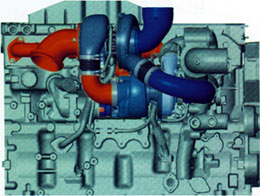The trend in commercial diesel applications points towards compressor ratios in excess of 4.0 as a likely response to the introduction of the U.S. EPA ( Environmental Protection Agency ) 2007 standards. Providing a reliable turbo for on-highway trucks above this pressure ratio is a significant challenge. Series turbocharging, though not ideal for every application, is emerging as a favored approach.
 In dual-stage series turbocharging, fresh air is drawn into the first stage compressor, where its pressure is raised about 2 to 2.5 times. This pressurized air is then drawn into the second stage compressor, where air pressure is further raised 2 to 2.5 times. The air is then cooled and the resulting charge air at the engine’s intake manifold is typically 4 to 5 times that of atmospheric pressure and about 20ºC higher than the ambient temperature.
In dual-stage series turbocharging, fresh air is drawn into the first stage compressor, where its pressure is raised about 2 to 2.5 times. This pressurized air is then drawn into the second stage compressor, where air pressure is further raised 2 to 2.5 times. The air is then cooled and the resulting charge air at the engine’s intake manifold is typically 4 to 5 times that of atmospheric pressure and about 20ºC higher than the ambient temperature.
By splitting the compression of the charge air between two turbos, both compressors operate at peak efficiency. Also, the lower pressure ratios for each stage mean lower rotating speeds, which results in improved reliability for the bearing systems, compressor wheels and turbine wheels.
“Series turbocharging offers the biggest benefits to engine suppliers who use Miller cycle or Atkinson cycle engines,” says Kevin Slupski, Director of Americans Applications Engineering at Honeywell Turbo technologies. “ The results demonstrate a significant improvement in engine thermal efficiency, leading to reduced fuel consumption. Another key benefit is the reduction in formation of NOx during combustion, one of the key regulated emissions in diesel and lean burn natural gas engines.”
Earlier developed for high-altitude mining equipment, series turbocharging was then adopted by Caterpillar for its ACERT on highway truck engines in 2003. Honeywell expects many large displacement engines for construction and mining equipment, marine applications and electric power generations to be designed for Miller cycle and series turbocharging by 2012 both in and outside of North America. The ever-tighter emissions requirements are making this technology also particularly attractive for smaller displacement medium-duty engines.
boostermagazine
September 2004
Honeywell





